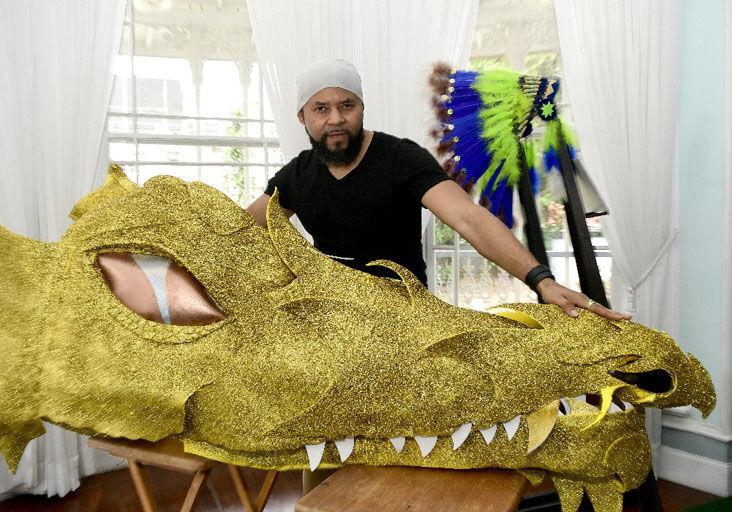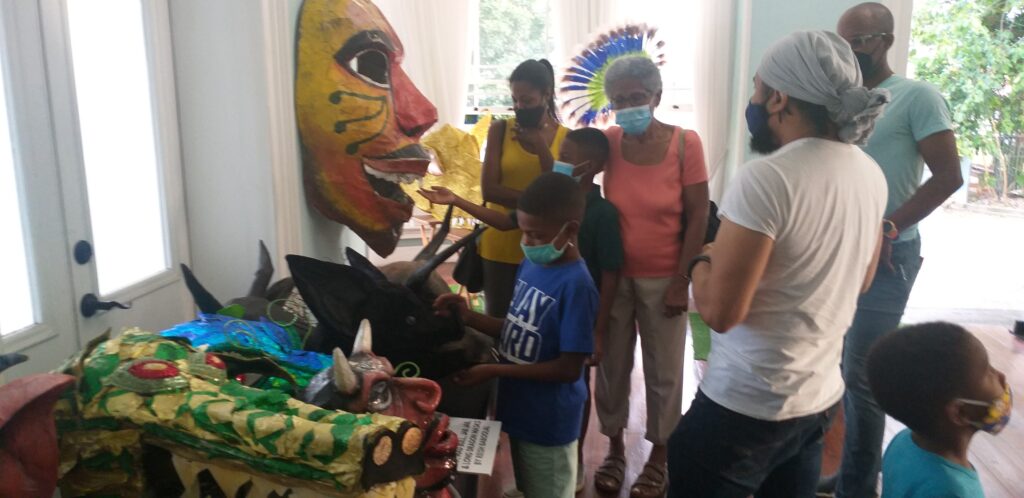Exhibition of Carnival Kings and Queens “Pantheon 2022”

Any spectator of the elaborate Trinidad and Tobago Carnival King and Queen costumes will not hesitate to describe the craftsmanship of these costumes as peculiar, because it is true that Trinidad and Tobago’s Carnival is unique and distinctive.
But those who wanted a more intimate experience with the King and Queen costumes of T&T Carnival had a grand opportunity at the recently concluded exhibition, “Pantheon 2022”, which satisfied their understanding of the creativity and the genius behind these costumes. The exhibition of the costumes was the first of its kind in this country.
The Artists’ Coalition of Trinidad & Tobago (ACTT) launched “Pantheon 2022—An Exhibition on the King and Queen Costumes of the Trinidad and Tobago Carnival”, at Mille Fleurs (one of the Magnificent Seven around the Queen’s Park Savannah in Port of Spain.)
The exhibition was twofold, as it not only showcased the unique costumes but also aimed to preserve and educate the public on the craftsmanship and legacy of years gone by. It was also part of the ACCT’s campaign to save costumes from destruction.

The exhibition was curated by Rubadiri Victor president of ACTT and was held under the auspices of the Office of Mayor of Port of Spain and in collaboration with the National Trust of Trinidad & Tobago and the Trinidad and Tobago Association of Wire-Benders.
During a recent interview with the Kitcharee, explained that Pantheon looks at the history of the King and Queen Costume tradition, its global uniqueness, high points, and heroes. “The exhibition also looks at the loss of legacy and skills that is currently happening due to the national failure to build institutions of memory. The exhibition also features a tribute to the Artisans at the Heart of the Trinidad and Tobago Festival civilisation,” Victor said.
Victor said 99.9 per cent of the King and Queen costumes are destroyed after Carnival. “Almost none of the great costumes of the past still exist. The preservation of present genius costumes and the rebuilding of the great costumes of the past is now an urgent national matter,” Victor said.
Since its opening on March 9, hundreds of patrons visited the exhibition to experience close to 100 installations.
On the grounds of Mille Fleurs there were six King and Queen costumes, five installations and three mannequined King tunics. Inside Mille Fleurs there were three King and Queen costumes, 33 panels of King and Queen exhibition information with 24 small information panels. There were 12 other installations pertaining to a Tribute to the Artisans, Wire-Benders, and this country’s traditional mas.
Victor said there has never before been an exhibition in this country celebrating the craftsmanship and the genius behind King and Queen costumes. “The King and Queen costumes are the crown spectacles of Trinidad and Tobago Carnival artisanry. Up to 30ft high and 30ft across, borne by a solitary human figure, they lead bands of costumed individuals as monarchs across stages and through the streets. They are the culmination of the imaginative, decorative, and engineering arts of the island. We have never had a National Exhibition celebrating them before, until now,” Victor said.

Victor believes that Trinidad and Tobago’s culture, particularly Carnival King and Queen Costumes, is not being properly documented. “Trinidad and Tobago has created a form of large-scale costuming unique in the world in its belief that the dancing-human-extended-costumed-body can signify any message imaginable—from the intimate to the epic. The other belief is that these large costumes must extend and translate human kineticism directly and creatively. Simply put, the costume must dance. The engineering skill required to make these costumes dance is unique in all of world costuming. It is a skill being lost because the elder artisans are passing on without it being documented. The destruction of costumes after Carnival means we do not have costumes to do forensics on to discover the techniques used in the past by elder masters.
“ACCT aims to try and get state and corporate Trinidad and Tobago to display select King or Queen costumes for at least a year in their lobbies, atriums, etc to save the costumes from destruction. We also want the gift of Carnival to live year-long and be a benefit to the landscape, elevating interiors and exteriors with its beauty, craft, and imagination. Four corporate and one State partner have so far stepped forward to adopt costumes. We hope that many more join the initiative,” Victor said.
He lamented that this country has many valuable artefacts, yet the powers that be have been careless in their preservation and salvaging. “This gambit is part of a wider campaign to get the State and corporate Trinidad and Tobago to mobilise a warehouse facility to store our valuable heritage artefacts and our priceless national collection.
“This National Heritage Warehouse will be a curated purpose-fitted facility that will house things such as the great Kings and Queens, antique industrial artefacts, archaeological material, and other valuable items. The Heritage Warehouse will house an institution like the Guild of Masters whose role will be to document, transmit, and institutionalise indigenous skills whilst rebuilding past masterpieces like the 100 greatest Kings and Queens of the past. The hope is that within this next year this warehouse facility can be mobilised as a solution,” Victor said.
